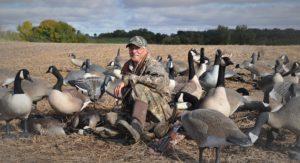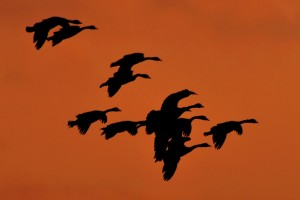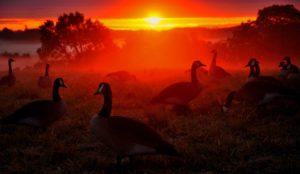Photography courtesy of Lowell Washburn, all rights reserved.
If I were to choose a single month as my favorite, I’d pick the month of October – hands down. Here’s some of what I like about October. Fall foliage is at its colorful peak, and the early autumn weather seems to agree with just about everyone. Generally speaking, October mornings are crisp and cool; the afternoons warm and sunny. Early morning frost may give way to the heady scent of autumn by midday. The hum of insects dominates the warming afternoon.
For those of us who love the out-of-doors, the list of potential activities – things to see and do — seem endless in October. Fish populations are conducting their fall frenzy, and there is no better time to catch a trophy grade walleye, bass, or musky. From the back reaches of local marshlands, flocks of mallards chatter in the predawn darkness. In the grassy uplands, the impending sunrise is greeted by the cackle of rooster pheasants; a raucous reminder that the season opener is only days away. In nearby woodlands, white-tail bucks are beginning to show off their newly polished antlers and the preliminary stages of the annual rut have already begun. Among the oaks, blue jays scream while fat fox squirrels busily bury acorns. Overhead, a myriad of bird species — everything from robins to red-tails — stream southward.
But it isn’t the weather, the fishing or even the fall colors that make October my personal favorite. What I love most are the geese. By now, locally raised Canadas have begun to marshal their ranks as small family groups merge into ever larger flocks. The fall harvest is in full swing, a fact that does not go unnoticed by hungry waterfowl. Following a summer of grazing like cattle, the birds’ collective appetites have now turned to the high carb nutrition found in recently cut fields of corn and soybeans. Livin’ is easy. With each passing day, the geese grow heavier.
Not all of the birds we’re seeing these days are homegrown. The deeper we get into October; the more goose populations become homogenized with migrants from the north. Canada geese come in many flavors, or to state it more correctly, many subspecies. Some arrive from the wetlands of prairie Canada. For others, the journey is much greater and Iowa is but a halfway point between remote subarctic nesting areas and the distant wintering grounds of Louisiana and Mexico. One of my favorite autumn visitors is the tiny cackling goose; a dominative arctic nesting three-pound look alike to our local giants. Regardless of the subspecies we encounter, the sight and sound of migrating Canada geese never fails to spark the imagination or to provide its own unique thrill.
During recent years, a lot of my goose hunting has been conducted on dry land – which can mean cow pasture, alfalfa, cut bean fields or corn stubble. Tracts of harvested soybeans are my favorite. A set of full bodied decoys can be seen for a long way in cut beans. Better yet, the close cropped flat-as-your-table-top landscape provides geese with a false sense of security – or at least that’s the way it’s supposed to work. I do not use any sort of commercially manufactured blind for field hunting. Instead, I prefer to just surround myself with lots of decoys and use them for cover. I also use three-foot-wide flags to capture the attention of distant flocks, and then employ a Sean Mann Eastern Shoreman flute call at close range.
Did I mention lunch? As you already know, goose hunting may sometimes require a long wait between flocks; a fact which makes your lunch box an essential piece of waterfowling equipment. Standard fare should include fresh cinnamon rolls, brownies, popcorn balls, trail mix, deer sausage, deer jerky, pumpkin pie, some kind of good Wisconsin cheese, smoked catfish, etc., etc. If I’m really making a day of it, the list will also include my Coleman stove, a carton of eggs, ham or bacon. Of course, there can be a down side to all this good eating. A couple of days ago, I – well I fell asleep shortly after breakfast. When I woke up again, I was startled to discover that a lone goose had silently slipped into the decoys and was now standing just a few yards away. Embarrassing.
Regardless of how long a hunter may actually have to wait, the eventual arrival of incoming Canada geese is always worth the effort and then some. This morning provided a good example. Upon selecting what I hoped would be an attractive tract of bean stubble, my decoys were in place by daybreak. But the early morning flight failed to materialize. By the time 9 o’clock rolled around, I had yet to see a single goose.
Then, while pouring a fresh cup of coffee, I suddenly spotted a distant string of dots on the horizon. The dots quickly became a half dozen geese. Working the flag, I could soon see that the birds were winging in my direction. A minute or two more and I could hear their plaintive calling. What came next could only be described as a text book scenario. Resembling a squadron of B52s, the loud mouthed honkers sailed — wing tip to wing tip — directly into the decoys. When the giant fowl began braking for touchdown, it would have been hard to miss the shot.
That’s how goose hunting is sometimes. Empty skies one minute. Limited out the next. Full plumed and in prime condition, the downed geese were perfect in every aspect. When slow roasted over glowing coals of aged apple wood, the birds would provide a feast that would be fit for a king. It’s too bad the month of October can’t last forever!
LW




 Tom Cope
Tom Cope Sue Wilkinson
Sue Wilkinson Susan Judkins Josten
Susan Judkins Josten Rudi Roeslein
Rudi Roeslein Elyssa McFarland
Elyssa McFarland Mark Langgin
Mark Langgin Adam Janke
Adam Janke Joe Henry
Joe Henry Kristin Ashenbrenner
Kristin Ashenbrenner Joe Wilkinson
Joe Wilkinson Dr. Tammy Mildenstein
Dr. Tammy Mildenstein Sean McMahon
Sean McMahon